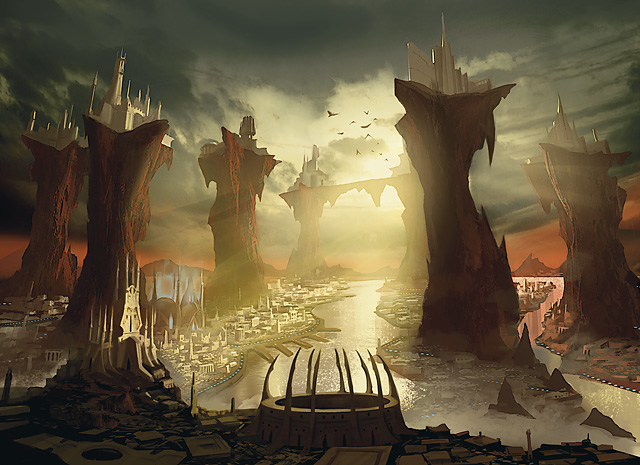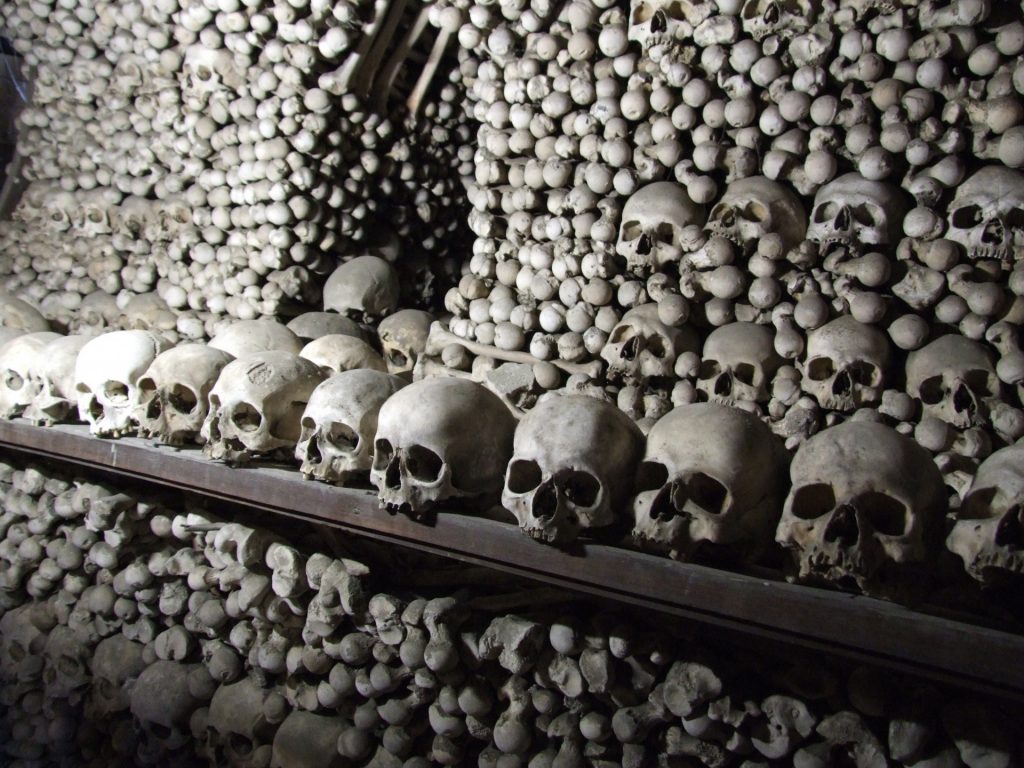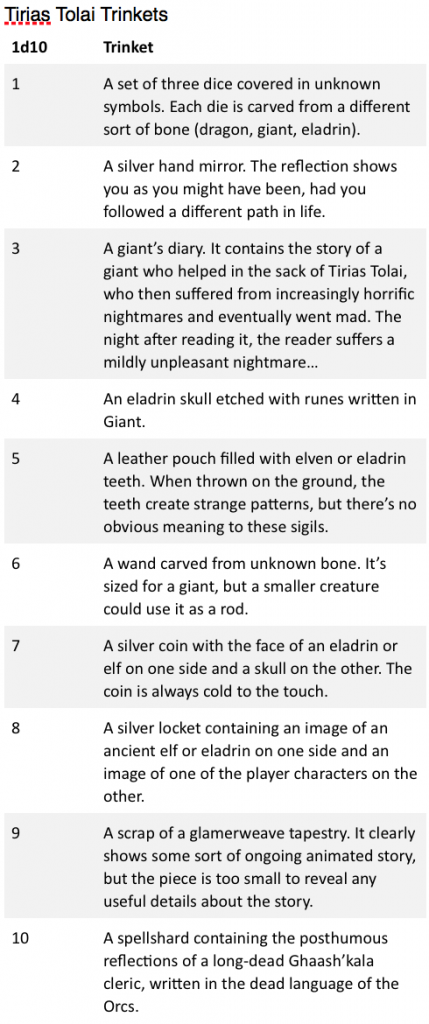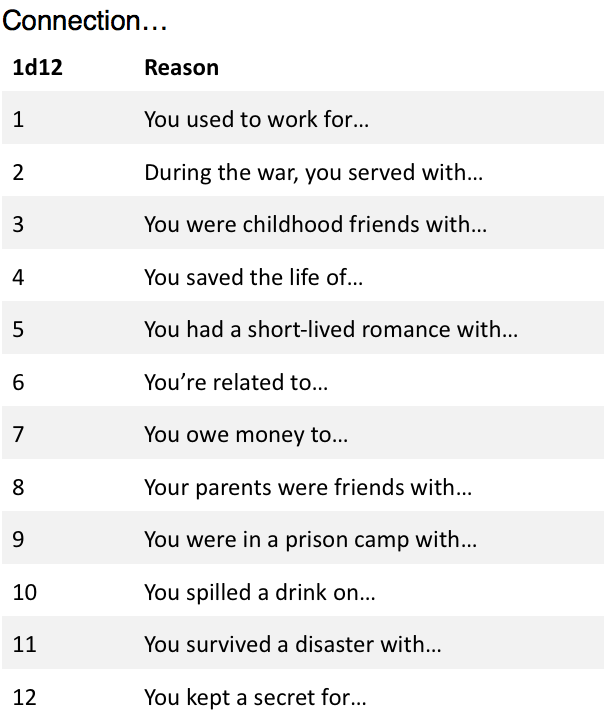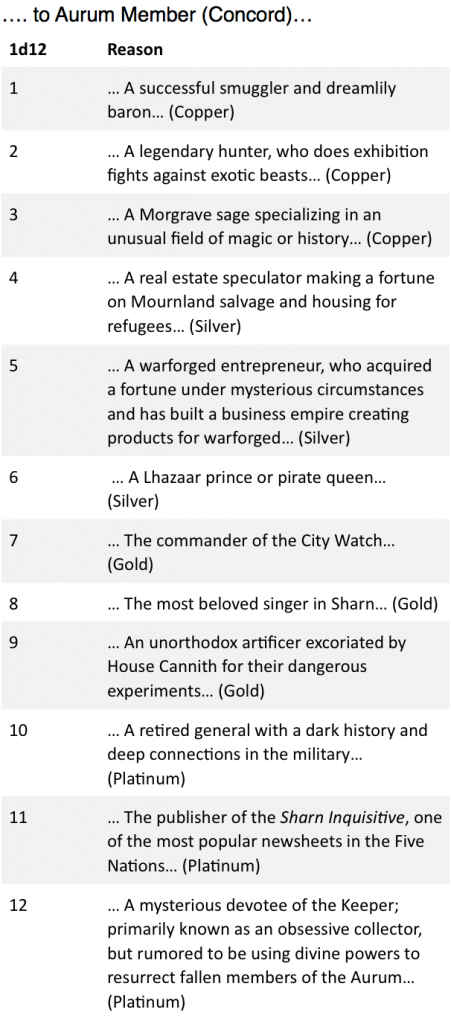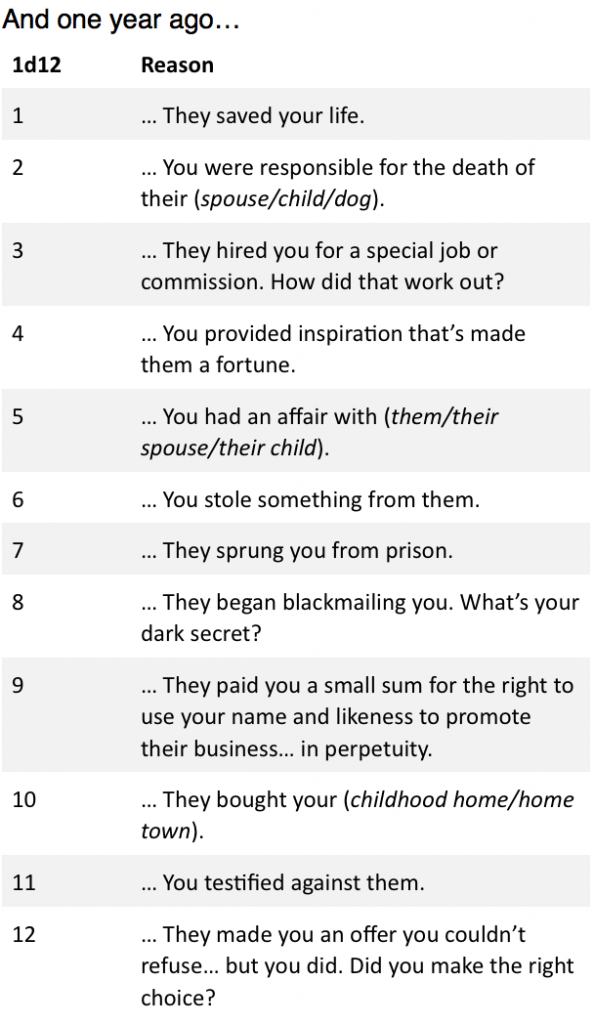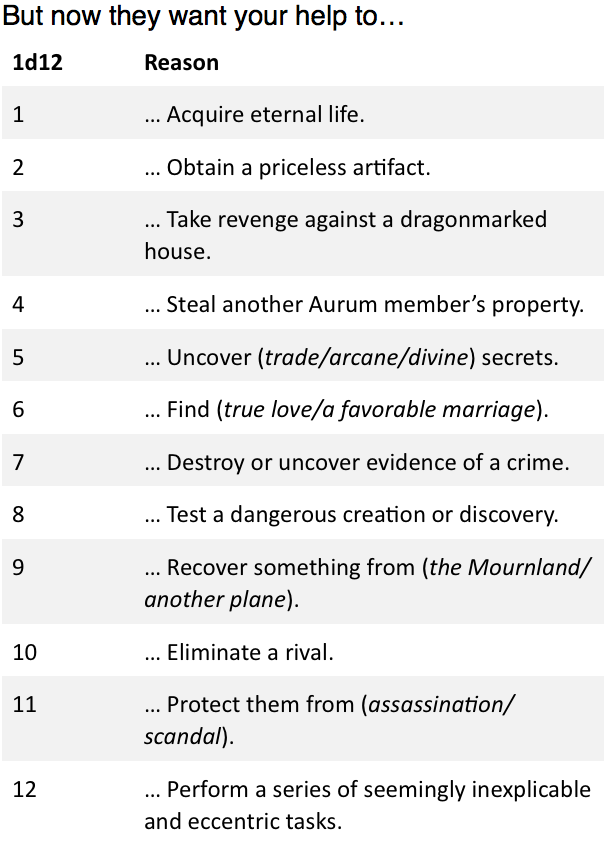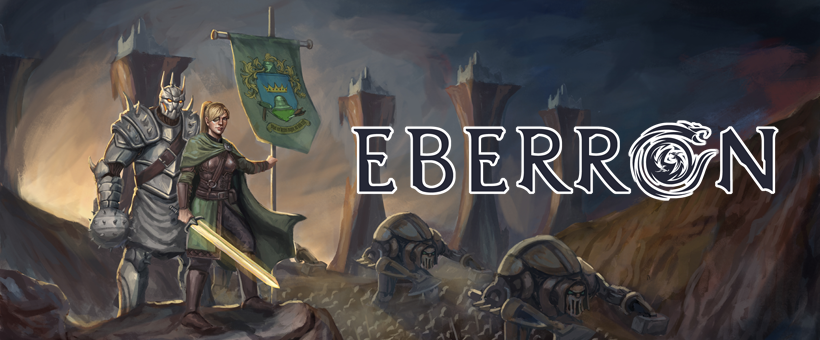
Eberron has a unique planar cosmology, but Rising From The Last War only scratches the surface of the planes; in this article and the upcoming Exploring Eberron, I’m digging deeper. Thanks to my Patreon supporters, who keep this site going and who chose this topic for my final January article!
LAMANNIA: THE TWILIGHT FOREST
Lamannia embodies primordial nature, untapped and untamable. It represents the raw power and majesty of the natural world. Lamannia is often called the Twilight Forest, and depicted as a realm of colossal trees and massive beasts. However, the forest is just one of the facets of Lamannia. Every natural environment is represented in Lamannia, contained in a layer that exemplifies and exaggerates its features. Windswept desert, raging ocean, endless plains; all can be found in Lamannia.
At first glance, Lamannia appears to overlap with a number of other planes. How does the Twilight Forest differ from the domain of the Forest Queen in Thelanis? How does the chill tundra differ from the icy layers of Risia? Shouldn’t the volcanoes of the Broken Lands be in Fernia? Well, there are dryads in the trees of the Endless Weald of Thelanis; sprites hide behind leaves and satyrs dance in the clearings. And in Fernia a blazing volcano could be home to Azer smiths forging wonders in its depths, or a balor who delights in unleashing streams of lava to destroy unwary adventurers. In Fernia, the volcano is a metaphor for industry or destruction. In Lamannia, it’s a metaphor for volcano. It’s an iconic, perfect example; it doesn’t need fey or fiends to make its point, because the volcano itself is the point. The elementals of Lamannia aren’t the anthropomorphic genies found in Fernia and Syrania; they are the pure, living essence of the elements, unburdened by any humanoid desire. Its primary inhabitants are beasts—both beasts that you might encounter in the wilds of Eberron, and massive creatures that can be seen as iconic representations of their type: the idealized incarnation of BEAR or WOLF.
Some scholars assert that Lamannia served as a blueprint for the material plane, that it was in Lamannia that the Progenitors perfected the ideas of storm and stone. They believe that the natural world is infused with the essence of Lamannia—and that druids and others who wield primal magic actually manipulate that Lamannian essence. Certainly, Lamannia is charged with primal power; druids who travel to the Twilight Forest can be overwhelmed by the sheer force of nature that infuses this place.
Lamannia lies close to the world, and it’s one of the easiest planes to reach. Its treasures are wood and stone—natural object imbued with elemental power, herbs and plants whose effects are far stronger than their mortal counterparts. But when you come to Lamannia, you are prey; there are many predators in this realm, and anyone who seeks to despoil the embodiment of nature will be hunted.
Universal Traits
Lamannia is a reflection of the natural world, intensified and exaggerated. The air is pure and clean, the water fresh and clear. Colors are impossibly vivid. It is suffused with life—a realm in which any stone could be an earth elemental, where any tree could be awakened.
Vegetation is nearly always in bloom and beasts are almost always in the peak of health. With the exception of layers such as The Rot, Lamannia reflects the ideal state of the natural world. Here are a few of the consistent traits of the plane.
Extended primal magic. When you cast a spell that draws on primal magic magic that has a duration of 1 minute or longer, the duration is doubled, to a maximum duration of 24 hours. Typically druids and rangers channel primal magic, but it’s up to the DM to decide in the case of each spellcaster. A paladin that follows the Oath of the Ancients might channel primal magic to cast their spells, while an Aundairian ranger could use arcane techniques.
Indomitable beasts.While in Lamannia, beasts and elementals have a +2 bonus to Constitution and advantage on saving throws against being charmed, frightened, or immobilized. When an elemental or beast first arrives in Lamannia from another plane, any magical effect that is charming it or binding it in any way is broken; this can be disastrous for an elemental airship that’s thrown into the plane.
The land provides. When you make a Wisdom (Survival) check to forage for food or shelter in Lamannia, you have advantage on the roll. The vegetation is bountiful and the land sustaining. It may be difficult to forage in the Broken Land, but you’ll at least have advantage to help you with the roll.
Primordial matter. It is difficult to destroy or contaminate the matter of Lamannia. An ongoing purify food and drink effect cleanses any sorts of poisons or contaminants from beyond the plane. In addition, natural materials such as wood and stone are tougher than their mundane counterparts. When trying to destroy such objects, increase the Armor Class suggested in Chapter 8 of the Dungeon Master’s Guide by 3 and double the hit points of the object.
Most layers of Lamannia follow a traditional day-night cycle. However, layers aren’t synchronized and likewise don’t match any time zone in Eberron. There is only one moon in the sky of Lamannia; a Wisdom (Nature) check with a DC of 10 will identify it as Olarune, though it appears larger than in the sky of Eberron and is always full.
Denizens of Lamannia
A common story of Lamannia tells of an explorer who passed through a manifest zone and found herself on a vast mountain peak. Pushing up the mountain, she was exploring a mysterious thicket when she was set upon by rats the size of wolves. She fought the rats, but was on the verge of being overwhelmed… until a giant beak flashed down and snapped up a rat in a single bite. The wide ‘thicket’ wasn’t natural briar; it was the nest of a gargantuan roc.
BEASTS
Lamannia is filled with all manner of beasts. Any natural creature can be found in Lamannia; indeed, some sages assert that the presence of a creature in Lamannia is what defines it as “natural.” These creatures fall into the following categories.
· Mundane animals are identical to their counterparts in Eberron. Any natural creature can be found in a layer with an appropriate environment. If such beasts are the first things player characters encounter in a visit to Lamannia, they might not realize they’ve traveled to another plane.
· Dire animals are creatures of remarkable size. Any beast described as ‘giant’ or ‘dire’ can serve in this role. Such creatures are more common than mundane animals; in the Twilight Forest, most owls are giant owls, and they prey on giant weasels and rats. While the existing animals are a place to start, any sort of beast can have a dire counterpart in Lamannia.
· Megafauna are gargantuan beasts. The roc is an example of Lamannian megafauna; those found in Eberron have been drawn through manifest zones or slipped between planes during coterminous periods. A megafauna serpent could use the statistics of a purple worm. These two creatures provide a rough scale of power for megafauna, but a DM can create a wider range of megafauna; adventurers could be hounded by a pack of gargantuan wolves. While these creatures are similar in form to beasts, they are typically classified as monstrosities. Between their vast size and their connection to the plane, they are immune to most effects that only target beasts, and you can’t charm a roc with a simple animal friendship spell.
· Totems are beasts that are beyond the tactical scale… creatures that can be measured in miles. The gnome explorer Tasker tells a tale of finding an island in the Endless Ocean that turned out to be an enormous turtle; another of his stories deals with a pack of lycanthropes living in the fur of a massive roaming wolf. Such totems aren’t natural creatures and don’t need to eat or excrete. Their origins and purpose are unsolved mysteries, but most sages believe that they are immortal spirits projected by the plane itself. Some claim that the totems are connected to all creatures cast in their image. Others believe that the totems are sources of primal power, that barbarians, shifters, and druids can receive power and guidance from them. All that is known for sure is that they’re immune to common spells, and to date there are no accounts of anyone successfully harming or communicating with a totem.
For the most part Lamannian beasts are no smarter than their counterparts on Eberron. However, there are animals that possess intelligence similar to that granted by the awaken spell. However, even these beasts generally follow their natural instincts and live wild lives. While in Sharn giant owls may own shops and run for city council, the giant owls of Lamannia are content to hunt the beasts of the Twilight Forest. So it’s possible to find creatures in Lamannia that speak Common or a Primordial dialect, but most have little interest in long conversations. Also, don’t forget that dinosaurs are natural beasts! While a megafauna owl is impressive, the megafauna version of a swordtooth titan (tyrannosaur) is a sight to see!
ELEMENTALS
After beasts, the most common inhabitants of the plane are elementals. Genies, mephits, and anthropomorphic elementals are found on other planes; the inhabitants of Lamannia are pure and raw in form. These include the standard earth, fire, air, and water elementals, but they can come in a wide array of sizes and forms. Adventurers exploring the broken lands could encounter tiny globs of lava crawling across the land… while the leviathans of the Endless Ocean and the elder tempests of the First Storm are forces of apocalyptic power. The elementals of Lamannia are the spirits commonly summoned and bound by the Zil, used to propel lightning rails and airships. While intelligent, these elementals are utterly alien. They have little concept of time, and perceive the world around them though the balance of elements. The sole desire of most elementals is to express their element: to burn, to flow, to fly. Many have an antagonistic attitude towards spirits of other elements, which drives the deadly conflict in the Broken Land. This is another obstacle in dealing with elementals, as they tend to perceive humanoids as globs of water. While it’s possible for a character that speaks Primordial to talk with a Lamannian elemental, it’s usually difficult to establish any sort of common basis for negotiation. Still, there are legends of wandering druids who “befriended earth and air;” anything is possible!
HUMANOIDS
The merfolk came to Eberron from Lamannia, and their ancestors remain in the Endless Ocean. These primordial merfolk are closer to their elemental roots than their counterparts in the seas of Eberron; while they are just as intelligent as their cousins, they are driven by primal instincts. They wield druidic magic, but they don’t craft tools or structures. This serves as a model for other humanoid natives of Lamannia. Any race with a strong primal connection could be tied to Lamannia, but natives of Lamannia are driven by instinct and avoid the trappings of civilization. There could be tabaxi dwelling in the branches of the Twilight Forest, but if so they will feel feral and wild.
During the Silver Crusade, a significant number of lycanthropes made their way or were exiled to Lamannia. While in Lamannia, a lycanthrope cannot spread the curse to anyone other than their offspring. The unnatural impulses of the curse—the drive to prey on innocents, the bloodlust that can cause a victim of lycanthropy to lose control of their actions—are suspended while they remain on the plane. Primal instincts are amplified; Lamannian werewolves remain predators and take joy in the hunt. But they aren’t driven to evil and remain in full control. Packs and communities of lycanthropes are scattered across the layers. Most are descended from lycanthropes who fled Eberron to escape both the templars and the dark power whose corrupting influence led to the crusade; these shapeshifters embrace their primal nature and rarely assume humanoid forms. But there are also packs descended from afflicted templars who chose exile over death, who strive to preserve the beliefs and traditions of their ancestors. There are bitter feuds between these afflicted templars and the “first wolves” and other lycanthropes of Lamannia, but the templars can be valuable allies for planar travelers.
There are also a handful of druids and rangers who have crossed into Lamannia and chosen to remain in this primal paradise. Many run with lycanthrope packs, embracing their feral instincts and spending their days in wild shape. Others act as planar shepherds, seeking to minimize the impact of dangerous manifest zones and to help unwary travelers.
HIGHER POWERS
There are no celestials or fiends in Lamannia. It is a realm of elementals and beasts, and the elementals are alien and untamed. Yet explorers often report a feeling that they are being watched. And there are times when random events seem to be guided by an unseen hand. When outsiders have sought to bring industry to bear in Lamannia, they have been found by megafauna or elder elementals, or struck by especially vicious turns of weather. It’s possible that this is the work of the totems—that totems possess omniscience and great influence over their layers. Or there could be a greater power that watches over the entire plane. There is a single moon in the sky above every layer, the moon Olarune; some scholars assert that this is the consciousness that governs the plane. This is reflected in Eldeen shifter traditions that predate the practices of the Wardens of the Wood; shifter druids suggest that it was Olarune who created the shifters, and that the first lycanthropes were her champions. It is up to the DM to decide if there’s any truth to these tales.
Layers of Lamannia
Like many of the planes, Lamannia is made up of layers—a connected web of demiplanes, each highlighting a particular aspect of primal nature. The scope of any single layer is up to the DM as suits the needs of the story. One layer in Lamannia might contain a single colossal mountain peak; on the other hand, the Twilight Forest could be as large as Khorvaire itself (or even Eberron!). The edge of a layer could be an impassable physical barrier, or it could wrap around onto itself; sail far enough in the Endless Ocean and you’ll find yourself back where you began.
The layers of Lamannia are connected by physical portals, but these portals often only allow travel in one direction. Any deep pool of water may connect a layer to the Endless Ocean; but while you can get to the Ocean by diving into a pond in the Twilight Forest, but there’s no gate back to the Forest on the other side. The Endless Ocean contains small islands; people who explore these islands will find they have moved to a new layer.
The Twilight Forest
The sky is hidden by the dense canopy of this vast rainforest, leaving the forest floor in an endless twilight. The trees are over a hundred feet in height—impressive, certainly, but not as tall as the greatpines of the Towering Wood in the Eldeen Reches. But as people explore the Twilight Forest, they will come upon strange ridges and walls of wood. Some come together, forming twisted wooden canyons. Following these, explorers will find that they are the roots of truly colossal trees, vast titans wider and taller than the towers of Sharn. The Twilight Forest as mortals experience it lies in the shadow of the grander canopy that rises far above it, and these mighty trees are home to megafauna and mightier beings.
The Twilight Forest is wild and untamed. However, explorers can find wide tracks through the lower forest. Survival experts may recognize that these aren’t tracks formed by humanoid hands; rather, they are the paths of totems, who have crushed the lesser forest beneath their colossal feet. The Forest is filled with beasts; mundane and dire creatures in the lower forests, megafauna in the grand canopy above it, and the occasional passage of totems. There are multiple communities of lycanthropes scattered throughout the lower forest. A clan of wererats have carved out a warren in the roots of a colossal tree, while a pack of wild wereboars feuds with werewolves descended from exiled templars. An ancient elf druid named Haral, who spends most of her time in the form of an owl, does her best to maintain order; she is assisted in this by a megafauna owl she calls Ruark. However, the Twilight Forest is larger than the Eldeen Reaches; these are just a few examples of the inhabitants of the forest.
Another noteworthy area is the Graveyard. Of all of the layers, the Twilight Forest is closest to Eberron. There are many manifest zones between the Twilight Forest and the material plane, and when the planes are coterminous it’s possible for people—or objects—to pass through. The region known as the Graveyard contains a number of manifest zones that are tied to the oceans of Eberron, and to the air above them—and over the course of thousands of years, they have caught a number of ships in their net. The focal point of these manifest zones are dozens of feet above the ground. First of all, this means that it’s not easy for stranded travelers to find their way back; second, this means that ships fall when they pass through, causing damage and often killing many of the travelers. So the Graveyard contains the wrecks of ships from many eras—an ancient Aereni galleon, a Lhazaar vessel, a recently lost Lyrandar airship. This provides an opportunity to introduce outside influences to the Twilight Forest, or to have forgotten treasures hidden in Lamannia. A Dhakaani vessel holds a priceless and powerful artifact long sought by all of the Heirs of Dhakaan… but the vessel was infected by spawn of the Daelkyr, and these have carved out a foul warren beneath the ship.
Elementals don’t have an especially strong presence in the Twilight Forest, but they are still present throughout it. A gust of wind, a pool of water, a rolling stone—in Lamannia, any of these things could be alive.
The Broken Land
The Broken Land is a volcanically active region filled with high mountains and lava plains. There are constant eruptions, and the layer is home to many fire and earth elementals, who engage in an ongoing environmental conflict. Fire elementals flow out with the lava as volcanoes erupt; earth elementals work to contain the eruptions and to rebuild the shattered peaks, only to have them erupt again. Few beasts manage to thrive in this layer, but there are some tough dinosaurs who’ve clawed out a niche. While this region has fewer connections to Eberron than the Twilight Forest, it’s also possible to find shipwrecks or remnants of other travelers here; it’s certainly a harsh and deadly landscape for adventurers who are stranded here or those who must recover a lost relic from this place.
The Endless Ocean
This layer reflects the majesty of the ocean depths. It is home to a vast array of fish and aquatic beasts, along with merfolk tribes and a wide range of water elementals… from simple sentient currents and weirds all the way to massive leviathans. Megafauna battles are common, and this is the source of the tale of the island that turned out to be a totem turtle. True islands are few and far between, and most are actually portals to other layers of Lamannia. There are many manifest zones spread across the Endless Ocean, almost all of which connect to the ocean depths of Eberron.
The First Storm
A layer of plains and low hills, this region is permanently lashed by hurricane winds and endless storms. Beasts huddle in caves and the limited shelter, while all manner of elementals clash in the storm-lashed plains. A massive elder tempest drives the heart of the storm; during the Sundering of Sarlona, an apocalyptic cult in Ohr Kaluun sought to bring this elemental to Eberron, believing it would destroy the world.
The Rot
Decay is part of nature, and this is reflected in the Rot. This relatively small layer is swamplike, filled with fallen, rotting trees. There are corpses of megafauna beasts scattered around the layer, and giant insects and other massive scavengers prey on their remains. There’s a community of wererats thriving in the Rot, and there could be a small outpost of the Children of Winter who found there way here. While this is a symbol of death and decay, it is entirely natural; the undead have no place here. It’s possible a necromancer could arrive here, hoping to animate the massive corpses; however, this would violate the theme of the plane, and if there is any higher power at work in Lamannia it would direct forces to counter this. While most layers of Lamannia are free from disease, disease is itself part of nature; a manifest zone tied to the Rot could spread plagues into the surrounding region.
Titan’s Folly
Lamannia is filled with precious natural resources; it’s hardly surprising that an advanced civilization would try to harvest them. During the Age of Giants, the Cul’sir Dominion set up a research station and mining camp in a layer of Lamannia. After a decade struggling against megafauna attacks and elemental-enhanced weather, the outpost was finally overwhelmed and abandoned. It is a testament to the arcane engineering of the giants that anything remains of this structure… although it may be that it remains because the ruin itself has become a symbol of nature-reclaiming-civilization, becoming the theme of the layer. Vines and moss cover shattered walls, and the bones of giants are scattered throughout the remnants of this garrison. Valuable and powerful treasures may well be hidden in the Folly, but explorers will have to contend with aggressive elementals, dangerous beasts, and traps left by the long-dead giants themselves.
Other Layers
These are just a handful of the many layers of Lamannia. In developing a layer, think of a distinctive natural feature—a canyon; a desert; a lone mountain—and build the layer around it. What creatures would be found there? Have any outsiders taken up residence? Is there an unusual role for elementals? How does it connect to other layers, or to Eberron?
Manifestations of Lamanna
There are many ways for Lamannia to influence an adventure even if the player characters never leave the material plane.
MANIFEST ZONES
Lamannia is a prolific source of manifest zones. Quite often manifest zones are found at the heart of a region that resembles the connected layer: zones tied to the Endless Ocean are found underwater, while manifest zones tied to the Twilight Forest can be found in the Towering Woods, the King’s Forest, and other vast woodlands. However, it’s also possible to find Lamannian zones in areas with no obvious connection to the layer—such as the aquatic zones tied to the Twilight Forest that produce the Graveyard. Here’s a few of the common effects of Lamannian manifest zones.
Elemental Power. Manifest zones tied to Lamannia may have strong elemental resonance. When spells that summon elementals are cast in such a region, they’re treated as if they were cast at a level one higher than the spell slot that was expended. There are a number of these zones in Zilargo, and House Cannith and the Twelve are eager to find unclaimed zones. However, there are risks associated with them. Elementals may spontaneously manifest in such places; sometimes they linger for a long time (a pool tied to Lamannia could be inhabited by water weirds), but often they only linger for a few hours and then dissipate. Passing through such a zone can also impart a surge of power to an existing elemental; this can potentially allow a bound elemental to break free from its bonds.
Gateways. A manifest zone can serve as a direct portal between Lamannia and Eberron. Typical such portals only open under certain circumstances—often when the planes are coterminous, but the requirements could be even more restricted (for example, when the planes are coterminous and Olarune is full). Such gateways can allow adventurers to travel to Lamannia, but they can also be the source of hostile elementals or deadly megafauna. Rising From The Last War suggests the idea that what appears to be a ring of standing stones could be a group of slumbering earth elementals stranded in such a gateway.
Growth. A common effect of a Lamannian manifest zone is to enhance the growth of plants or beasts in the region around it. This is less about fertility (which is commonly associated with Irian) and more about the size and health of the beast. Animals are often drawn to such zones. House Vadalis is always searching for manifest zones with this trait, and many Vadalis enclaves are built in these zones.
Purity. Vegetation and water in such a zone are healthy and pure, as if constantly affected by purify food and drink. Such zones can be a valuable resource for small communities. Such regions may also manifest the ‘primordial matter’ described earlier; stone and wood may be unusually tough. The prison of Dreadhold is built in such a manifest zone; not only is the stone of the region denser than usual, it cannot be penetrated by scrying or teleportation.
Resistance. While Lamannian manifest zones can be useful tools for communities or dragonmarked houses, some zones actively resist and repel civilization. As noted in Rising From The Last War, weather, vegetation, and a rapid rate of decay can combine to quickly destroy structures built in the zone and overgrow the ruins.
These effects aren’t mutually exclusive; a manifest zone could have both the growth and resistance traits, and also become a gateway under specific circumstances. Zones can also have very specific effects; notably, the elemental power trait is often tied to a specific element. The weird-haunted pool enhances water elementals, but doesn’t help if you’re trying to summon fire elementals.
COTERMINOUS AND REMOTE
Lamannia has a swift planar cycle. It is reliably coterminous for a week around around the summer solstice, and remote for a week during the winter solstice; it can also become coterminous at other times, often related to the lunar cycle of Olarune.
While Lamannia is coterminous, the effects of Lamannian manifest zones are enhanced. In regions of unspoiled nature—such as the Eldeen Reaches, the wilds of Q’barra—fertility of both plants and animals is enhanced, and beasts conceived in these periods are often exceptionally strong and healthy. Primal spells that affect beasts or elementals are extended; if a spell has a duration of 1 minute or longer, the duration is doubled, to a maximum duration of 24 hours.
While Lamannia is remote, fertility rates drop and beasts born in these periods are often weak or sickly. Beast are often uneasy, and the duration of any primal spell that affect beasts or elementals is cut in half, to a minimum duration of one round.
LAMANNIAN VISITORS
The inhabitants of Lamannia rarely choose to travel to Eberron. Those few civilized creatures—lycanthropes, merfolk—are content in their primal realm and generally only cross over by accident. However, accidental visitors can be a source of trouble or adventure. A powerful elemental or a megafauna beast can pose a deadly threat to a region. Megafauna creatures can become local legends; imagine a Vadalis expedition seeking a legendary megafauna ape (which, if captured, might break free while on exhibition and climb the towers of Sharn!). There’s no records of a totem beast ever passing through to Eberron, and it’s possible that they cannot manifest beyond Lamannia.
LAMANNIAN TREASURES
Lamannia vegetation is prized by alchemists. Herbs and roots from Lamannia can produce exceptionally strong potions, and many types of Lamannian vegetation have innate magical effects; there are bushes in the Twilight Forest that naturally produce goodberries. Lamannian lumber likewise can have unusual traits, mirroring the densewood and bronzewood found in Aerenal. Lamannian wood and stone can serve as powerful focuses for primal magic, for creating figurines of wondrous power, or for tools designed to summon or bind elementals.
Lamannian Stories
Lamannia is a source of elementals and dire beasts. It is wild and untamed, strengthening primal magic and providing a haven to lycanthropes. It resists any intrusion by civilization. Here’s a few ideas for working it into your story.
· A Savage Land. When a party of adventurers unknowingly pass through a gateway, they must find a way to survive in this wild realm. This could be as simple as finding another manifest zone to take them home… or it could require them to survive in Lamannia for months while waiting for the planes to become coterminous. Another option is for the group to be stranded when their airship passes through a manifest zone and the elemental breaks free; in this case, the adventurers must decide whether to protect the other survivors, and deal with conflicts that arise among them.
· Megafauna Island. Due to close ties to Lamannia, there’s an island that is home to an unusual array of megafauna beasts. Adventurers could stumble onto this on their own, or they could be hired by an heir of House Vadalis who wants to investigate the rumors without drawing the attention of rivals in the house.
· The Great Beast. A Lamannian zone could realize a megafauna predator into the region, spreading terror among the locals. Must this creature be destroyed? Can it be returned through the zone, or is it even hostile?
· Lycanthropes. Lamannia suppresses the negative effects of the curse of lycanthropy. Adventurers could stumble upon a village of lycanthropes and jump to the wrong conclusion, not knowing that the influence of the local manifest zone allows them to control the curse. Alternatively, a group of benevolent lycanthropes could return to Eberron only to fall prey to the predatory impulses of the curse: can the adventurers capture these lycanthropes alive and help them return to the Twilight Forest?
· Relic Hunt. The trail of a powerful artifact leads to Lamannia. It might have been on a ship lost in the Graveyard, or it could be that an artificer needs Lamannian resources to complete an eldritch machine. Can the adventurers win this deadly race?
· At War With Nature. An Ashbound druid manages to establish a new Lamannian manifest zone in a major city, such as Fairhaven or Sharn. The resistance effect is causing the city to crumble, releasing elementals and wild vegetation. Can the adventurers find a way to remove the manifest zone? Alternately, House Cannith could be determined to create a bridge that allows them to harvest Lamannian resources… will they succeed, or will their efforts backfire dramatically?
· Unusual Flavor. The impact of a manifest zone can be felt just as part of the backdrop of a scenario. The village of Clearwater is in a hostile region, but it survives because of the small lake that provides fresh water and a seemingly inexhaustible supply of fish. In a small Eldeen village, the locals live in harmony with a breed of giant rabbits unknown elsewhere in Khorvaire. A tribe of shifters lives in the branches of the three massive trees that grow in a Lamannian manifest zone.
If you have questions or stories about what you’ve done with Lamannia, post them below!

